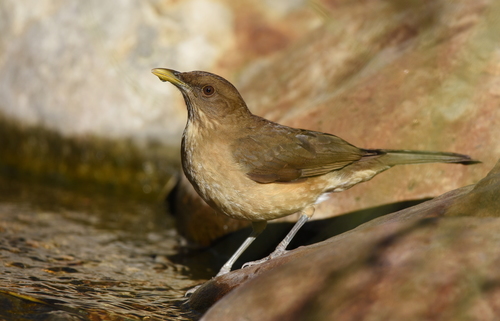
Clay-colored Thrush
The Clay-colored Thrush (Turdus grayi), also known as the Clay-colored Robin, is a common Middle American thrush found from southern Texas to northern Colombia. It plays a significant ecological role as a seed disperser and insectivore. In Costa Rica, it is the national bird, known locally as the *yigüirro*, and is celebrated in folklore and songs for its association with the start of the rainy season.
23-27 cm
Length
38-41 cm
Wingspan
Least Concern
Conservation Status
Distribution
Southern Texas (lower Rio Grande Valley) through eastern Mexico, Central America, and into northern Colombia. It has also expanded its range slightly northward in Texas in recent decades.
Lifespan
Typical lifespan in the wild is not well documented but is estimated to be around 2-3 years, with some individuals living longer.
Clay-colored Thrush's Habitat
Habitat Types
Woodlands, Forest edges, Savannas, Gardens, Parks, Cultivated areas with trees
Climate Zones
Tropical, Subtropical
Adaptations
Highly adaptable to human-modified landscapes, thriving in areas with a mix of trees, shrubs, and open ground.
Variations
Several subspecies are recognized, differing slightly in plumage color and size. For example, *T. g. grayi* is found in eastern Mexico, while *T. g. casius* inhabits Panama.
Appearance
Breeding Plumage
No significant difference between breeding and non-breeding plumage.
Seasonal Feather Changes
Minimal seasonal variation.
Sex Based Plumage Differences
Males and females have similar plumage.
Notable Features
Uniformly dull brownish plumage., Slightly paler throat with faint streaking., Yellowish bill., Brownish legs.
Diet and Feeding
Primary Foods
Fruits, Insects, Spiders, Earthworms, Other invertebrates
Foraging Behavior
Forages primarily on the ground, hopping and running to search for food. Also gleans food from foliage and occasionally catches insects in flight.
Specializations
No highly specialized feeding adaptations; its generalist diet allows it to exploit a variety of food sources.
Seasonal Diet Variations
Diet shifts with the availability of food. Fruit consumption may increase during fruiting seasons, while insects and other invertebrates are more important during other times.
Behavior
Social Structure
Generally solitary or found in pairs during the breeding season. May form small flocks outside of the breeding season.
Communication
Melodious song, often described as 'caroling'., Various call notes, including a sharp 'chut' or 'churt'.
Migration
Generally non-migratory, although some local movements may occur in response to food availability.
Territorial or Group Behaviors
Males are territorial during the breeding season, defending their nesting area with song and aggressive displays.
Conservation
Threats
Habitat loss (deforestation), Pesticide use in agricultural areas
Protection Programs
General habitat conservation efforts in its range., Protected areas (national parks and reserves) within its distribution.
Local National Laws
Protected as the national bird of Costa Rica.
Population Trend
Stable
Population Estimates
Global population is not precisely quantified but is considered to be large and not currently threatened.
Interesting Facts
National bird of Costa Rica.
Chosen for its familiar song that heralds the rainy season, a crucial time for agriculture.
Its song is often featured in Costa Rican folk songs and literature.
Reflecting its cultural significance and association with the country's identity.
The Clay-colored Thrush name comes from their nest.
They build large, bulky, cup-shaped nests cemented together with mud.
Faqs about Clay-colored Thrush
What does the Clay-colored Thrush sound like?
It has a melodious, fluting song, often described as a series of clear, whistled notes. It also has various call notes, including a sharp 'chut'.
Is the Clay-colored Thrush a robin?
While it is sometimes called the Clay-colored Robin, it is a thrush (family Turdidae). The term 'robin' is often applied to thrushes with reddish breasts, but in this case, it refers to its general appearance and behavior, which are similar to the American Robin.
Where can I see a Clay-colored Thrush?
They are common in a variety of habitats, including gardens, parks, and woodlands, from southern Texas to northern Colombia. Look for them foraging on the ground or singing from perches.
Copyright @ Nature Style Limited. All Rights Reserved.
 English
English